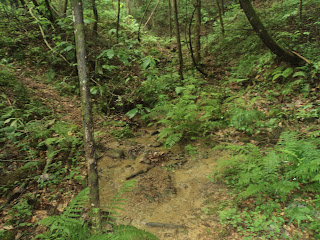Trail: Green Trail
Hike Location: Muscatatuck Park
Geographic Location: south side of North Vernon, IN (38.98842, -85.62524)
Length: 2.8 miles
Difficulty: 4/10 (Easy/Moderate)
Date Hiked: June 2021
Overview: A fairly flat loop around Muscatatuck Park's developed area.
Park Information:
http://www.muscatatuckpark.com/
Hike Route Map:
https://www.mappedometer.com/?maproute=876202Photo Highlight:
Directions to the trailhead: The signed entrance for Muscatatuck Park is located on the west side of SR 3/7 2 miles south of North Vernon. Drive the narrow winding park road 0.8 miles, noting the old quarry and Vinegar Mill along the Muscatatuck River to the left of the road. Park in the large gravel trailhead parking lot on the left across the main park road from the playground.
The hike: If the amenities you find at Jennings County's Muscatatuck Park remind you more of a typical state park than a typical county park, there is good reason for that. The park had its founding in 1921 as Vinegar Mill State Park, Indiana's fourth state park; it was named for the old stone-cutting mill along the Muscatatuck River you passed on your drive in. The park was developed in the 1930's by the depression-era Civilian Conservation Corps (CCC) and Works Progress Administration, and some of their constructions are still in use today.
During the 1950's and 1960's, the park's small size caused the State of Indiana to consider other uses for the land, which included wildlife raising and youth camp. In 1968, the State decided to give the land to Jennings County to be managed by its newly formed Parks and Recreation Board. The county struggled to find money to manage the park at first, but in the late 1990's facility upgrades and funding improvements turned this park into the crown jewel of Jennings County's park system. I came here on a humid morning in mid-June of 2021 when the park was celebrating its 100th anniversary, and I was very impressed with what I found here.
The park's unusual history is still evident today, as several structures from its wildlife raising and camp days still dot the area. In terms of facilities, the park features numerous picnic areas, a 50-site developed campground, and 4 hiking trails totaling nearly 10 miles. The Green Trail described here is the park's easiest trail in the sense that it does not descend to the Muscatatuck River, but it offers a true loop through nice woods. Also, it makes a nice family hike because it can be accessed in several places, thus giving you the option to bail on the hike if the kids get tired or bored.
 |
| Information kiosk at trailhead |
Start at an information kiosk at the rear of the parking area, where a narrow entrance trail enters the woods. Almost immediately you intersect the Green Trail, which goes straight and left. I turned left here and used the trail going straight as my return route, thus hiking the loop counterclockwise. The Green Trail is unmarked except for brown carsonite posts bearing green arrows at intersections such as this one, but I had little trouble following the trail.
 |
| Hiking through nice forest |
The single-track dirt trail traces around a finger ridge before assuming a general northbound course with picnic shelters and the developed park area just off to the left. Oak trees dominate the ridges at Muscatatuck Park, and the dense forest with large trees displays the age of this park. Where the Blue Trail exits right to head for the river, angle left to cross the north park entrance road at 0.5 miles.
 |
| Trail intersection |
After tracing around another finger ridge, the Black Trail exits right at 0.8 miles. Next the trail enters a shrubby area with younger broadleaf trees and some pine trees before passing through a wetland area with a small pond. This section of trail was rather muddy on my visit, so I recommend waterproof hiking boots for this hike despite the flat terrain. |
| Small pond beside trail |
Near 1 mile into the hike, you need to ignore some side trails that exit right as the Green Trail crosses the park's west entrance road. Again, watch for the green arrows on carsonite posts. Some more slippery mud may need to be negotiated before you pass through the sunny corner of a mowed-grass field at a small picnic table. This picnic table makes a nice place to sit and rest near the midpoint of this hike.
 |
| Corner of sunny meadow |
Some wooden footbridges carry you over small streams as the trail continues southbound with a ravine downhill to the right. Soon the campground area comes into view uphill to the left, and for the next mile or so the Green Trail traces the edge of the campground area. A maze of connector trails criss cross in this area, but the connector trails are marked with gray arrows in contrast to the green arrows for the Green Trail. The forest here features some nice beech, maple, and oak trees.
 |
| CCC-built picnic shelter |
After making a loose and winding semicircle around the campground, the trail heads north for the final leg back to the trailhead. At 2.7 miles, you cross a gated gravel road that serves a CCC-built stone picnic shelter to the right. After a quick detour to check out the shelter, you close the loop in only a few hundred more feet. Hike the last few feet out the short entrance trail to complete the hike. On your way out, be sure to check out the old Vinegar Mill and adjacent quarry. If you want to do more hiking, a separate trailhead at the mill accesses the park's River Trail, which goes up and down the west bank of the Muscatatuck River.
































